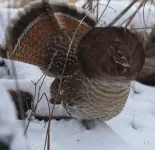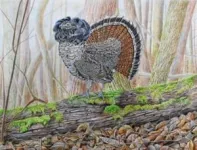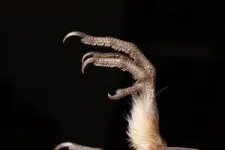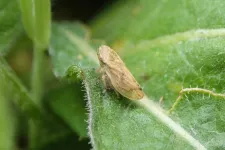(Press-News.org) Despite decades of decline, a genetic analysis of ruffed grouse reveals that Pennsylvania’s state bird harbors more genetic diversity and connectivity than expected. The findings suggest that the iconic game bird could be maintained in persistent numbers if appropriate protections are implemented. The study, led by Penn State and Pennsylvania Game Commission researchers, published in the journal Molecular Ecology.
According to the researchers, Pennsylvania’s ruffed grouse populations have declined by up to 70% since the early 1960s, with birds in the southern part of the state particularly affected by West Nile virus, which is spread by mosquitoes, and by habitat fragmentation due to development.
“By all typical metrics, the ruffed grouse is in a state of rapid decline,” said Julian Avery, associate research professor of wildlife conservation at Penn State and co-author of the paper. “Yet, until now, no one had used genetic tools to investigate the effects of this decline at a deeper level. By applying whole-genome sequencing, we have found that the bird is genetically better off than we suspected, which means that habitat protection and other management interventions can work to protect this species.”
Leilton Luna, postdoctoral researcher at Penn State and corresponding author of the paper, explained that when an organism’s population size drops too low because of disease or habitat loss, inbreeding can occur, which can lead to a decline in genetic diversity over time.
“Populations with low genetic diversity have a harder time evolving in response to changing environmental conditions and are at greater risk of extinction,” Luna said. “In the case of the Pennsylvania ruffed grouse, due to the sharp population decline, it certainly doesn't have the same healthy genetic conditions as it did in the past. Even so, the current levels of genetic diversity and connectivity give us great hope for the preservation of this species.”
As an initial step, the team produced the first high-quality reference genome for ruffed grouse. A reference genome, Luna said, is a representative example of a particular organism’s genes.
“This reference genome serves as a standardized genetic baseline, facilitating accurate comparisons of genome-wide diversity between individuals and populations,” Luna said. “Additionally, this genomic resource will enable us to investigate important questions, such as whether specific genetic components, like adapted genes, contribute to varying population responses to West Nile virus in different ruffed grouse populations.”
To investigate the population health of the ruffed grouse in Pennsylvania, the research team sequenced 54 individual bird genomes within habitats that were both fragmented by development and intact. The researchers examined the sequence data for evidence of gene flow, which indicates that genetic material is readily exchanged among migrating populations.
“We compared each individual to every other individual that we sampled,” Luna said. “By doing this, we were able to tell if the birds all belong to a single geographic population or to different populations, as well as how environmental factors such as habitat fragmentation and terrain elevation shape the effective dispersal of birds and, therefore, the exchange of genes.”
He said the team’s DNA analysis provided weak evidence of population subdivision across the state, although the researchers identified reduced genetic connectivity in the south, where the bird’s habitat is fragmented by human development.
“This tells us that the population may not be doing as bad as we expected,” Luna said. “It also helped us to inform wildlife managers which areas would most benefit from the development of habitat corridors. However, it is just a snapshot of the population at this particular moment. In the future, we hope to analyze the DNA of museum specimens so we can compare the genetic diversity and connectivity of today’s populations with those from before West Nile virus was present and before the habitat was so fragmented.”
Surprisingly, the team said, it also stumbled onto the presence of two genetic “anomalies,” called chromosomal inversions. These occur when a segment of DNA breaks off and then reattaches in reverse order.
“We found chromosomal inversions within some of the individuals we sampled, and these were found in individuals from across the Commonwealth,” said co-author David Toews, assistant professor of biology at Penn State.
“The data are very clear,” he said. “There are these two large chunks of the ruffed grouse genome that are highly differentiated from the rest of the genome, and they are not associated with any obvious geographic pattern among the birds. It adds a fun ruffle to the story.”
Toews noted that chromosomal inversions previously were found in other bird species and were expressed via different plumage patterns or more aggressive behaviors, for example. He said the team does not yet know how the inversions might affect the ruffed grouse. It’s a topic the team plans to further investigate.
In the meantime, Toews said, the chromosomal inversions have important implications for conservation.
“On the surface, all ruffed grouse look fairly similar, but they actually have deep genetic differences,” he said. “In the context of conservation, it may be important to think beyond the species overall to consider protecting individuals with these genetic variations.”
Avery noted that Penn State has a long history of working with state agencies — such as the Pennsylvania Game Commission, Pennsylvania Fish and Boat Commission and Pennsylvania Department of Conservation and Natural Resources — to collect and analyze scientific data that can help inform conservation strategies. He said the team’s findings suggest that certain management interventions may help the bird to maintain healthy populations. These include:
Creating and maintaining habitats that functionally connect forested regions and populations
Evaluating the impact of hunting to ensure harvest is not contributing to the decline of more vulnerable populations
Implementing periodic genetic monitoring to track changes and assess whether habitat interventions lead to positive genetic changes
“Not only do ruffed grouse play an important role in the ecosystem, but they are also really interesting,” Avery said. “The males make this drumming sound in the spring to attract mates. You can physically feel the bass when they're drumming in the woods. They also pair the drumming with a flashy display of ornamental feathers and a spread tail, similar to the over-the-top performance of a male peacock. To top it off, during the fall, ruffed grouse grow these fascinating extensions of their toe scales that may help to increase surface area during the winter months. They’re just beautiful and bizarre, and they deserve our conservation attention.”
Other authors on the paper include Lisa Williams, wildlife biologist; Kenneth Duren, game bird section supervisor; and Reina Tyl, wildlife biologist, all at the Pennsylvania Game Commission.
The Pennsylvania Game Commission supported this research.
END
Ruffed grouse population more resilient than expected, genetic study finds
Results suggest that appropriate protections in Pennsylvania could prevent further declines in the species
2023-10-04
ELSE PRESS RELEASES FROM THIS DATE:
Ohio State awarded $20 million to put science behind tobacco product regulation
2023-10-04
The Ohio State University (OSU) has been awarded a $20 million Tobacco Center of Regulatory Science (TCORS) grant from the Food and Drug Administration’s (FDA) Center for Tobacco Products and National Institutes of Health.
The OSU-TCORS grant is a collaboration of experts from the colleges of medicine, public health and law organized and implemented through the Center for Tobacco Research at The Ohio State University Comprehensive Cancer Center – Arthur G. James Cancer Hospital and Richard J. Solove ...
Both high and low HDL cholesterol tied to increased risk of dementia
2023-10-04
EMBARGOED FOR RELEASE UNTIL 4 P.M. ET, WEDNESDAY, OCTOBER 4, 2023
MINNEAPOLIS – Having either high or low levels of high-density lipoprotein (HDL) cholesterol, or “good” cholesterol, is tied to a small increased risk of dementia in older adults, according to a study published in the October 4, 2023, online issue of Neurology®, the medical journal of the American Academy of Neurology. This study does not prove that high or low levels of HDL cholesterol cause dementia; it only shows an association.
“Previous studies on this topic have been ...
Meadow Spittlebug’s record-breaking diet also makes it top disease carrier for plants
2023-10-04
New research fueled in part by citizen scientists reveals that the meadow spittlebug—known for the foamy, spit-like urine released by its nymphs—can feed on at least 1,300 species of host plants, more than twice the number of any other insect.
The study, which is published today in the journal PLOS ONE, could be especially important in the effort to stop the bug from spreading a type of bacterium that has caused the death of crops across the world, including olive trees in Italy, grapevines in California, citrus trees in South America, and almond trees in Spain.
“Thirteen hundred host plants means 1,300 opportunities ...
Keshav Pingali to receive ACM-IEEE CS Ken Kennedy Award
2023-10-04
ACM, the Association for Computing Machinery, and IEEE Computer Society have named Keshav Pingali, the W.A.”Tex” Moncrief Chair of Grid and Distributed Computing at the University of Texas at Austin, as the recipient of the 2023 ACM-IEEE CS Ken Kennedy Award. The Ken Kennedy Award recognizes groundbreaking achievements in parallel and high performance computing. Pingali is cited for contributions to high-performance parallel computing for irregular algorithms such as graph algorithms. He is also cited for leadership on the Galois Project, which provides a unifying framework for parallelizing both irregular and regular algorithms.
Pingali has made deep and wide-ranging ...
Pandemic boosted gardening, hunting in NYS
2023-10-04
A survey of New York state residents found that nearly half of respondents increased the amount of time they spent on wild and backyard food in the early months of the COVID-19 pandemic, confirming anecdotes about increases in activities such as sourdough baking, fishing and gardening. People also tended to eat the food they produced, researchers found, possibly buffering the generally less healthful eating that was common at the time.
“This was the period of 2020 when you couldn't find tomato cages, seeds were out of stock, and there were reports about record numbers of people hunting and ...
Study identifies jet-stream pattern that locks in extreme winter cold, wet spells
2023-10-04
Winter is coming—eventually. And while the earth is warming, a new study suggests that the atmosphere is being pushed around in ways that cause long bouts of extreme winter cold or wet in some regions.
The study’s authors say they have identified giant meanders in the global jet stream that bring polar air southward, locking in frigid or wet conditions concurrently over much of North America and Europe, often for weeks at a time. Such weather waves, they say, have doubled in frequency since the 1960s. In just the last few years, they have killed hundreds of people and ...
Department of Defense grant awarded to study metastasis in bladder cancer
2023-10-04
A Weill Cornell Medicine researcher has received a $610,000 grant from the Department of Defense to investigate the mechanisms causing DNA instability that potentially drives metastasis in bladder cancer. The research also aims to identify methods to intercept this spread. The Peer-Reviewed Cancer Research Program (PRCRP) Idea Award funds innovative, high-risk, high-reward basic cancer research. One of the goals of the PRCRP program is to decrease the burden of cancer on service members and their families, veterans, and the American public.
“Approximately 40% of patients with muscle-invasive bladder cancer develop metastases, where ...
Simultaneous large wildfires will increase in Western U.S.
2023-10-04
Contacts:
David Hosansky, UCAR/NCAR Manager of Media Relations
hosansky@ucar.edu
720-470-2073
Audrey Merket, UCAR/NCAR Science Writer and Public Information Officer
amerket@ucar.edu
303-497-8293
Simultaneous outbreaks of large wildfires will become more frequent in the Western United States this century as the climate warms, putting major strains on efforts to fight fires, new research shows.
The new study, led by scientists at the National Center for Atmospheric Research (NCAR), focused on wildfires of 1,000 acres or larger. It found that wildfire seasons in which ...
New UCF technology could reduce lag, improve reliability of online gaming, meetings
2023-10-04
Whether you’re battling foes in a virtual arena or collaborating with colleagues across the globe, lag-induced disruptions can be a major hindrance to seamless communication and immersive experiences.
That’s why researchers with the University of Central Florida’s College of Optics and Photonics (CREOL) and the University of California, Los Angeles, have developed new technology to make data transfer over optical fiber communication faster and more efficient.
Their new development, a novel class of optical modulators, is detailed in a new study published recently in the journal Nature Communications. Modulators can be thought of as like a light switch that controls certain ...
Rice alum Louis Brus awarded Nobel Prize in Chemistry
2023-10-04
Rice University alumnus Louis Brus (’65) has been awarded the Nobel Prize in Chemistry for the “discovery and development of quantum dots,” nanosized particles with unique properties “that now spread their light from television screens and LED lamps,” according to a Royal Swedish Academy of Sciences announcement today.
Brus, who started his undergraduate education at Rice in 1961, shares the distinction with Moungi Bawendi and Alexei Ekimov. Their work has been crucial to the development of nanotechnology, which has helped drive major computing ...
LAST 30 PRESS RELEASES:
Brain immune cells may drive more damage in females than males with Alzheimer’s
Evidence-based recommendations empower clinicians to manage epilepsy in pregnancy
Fungus turns bark beetles’ defenses against them
There are new antivirals being tested for herpesviruses. Scientists now know how they work
CDI scientist, colleagues author review of global burden of fungus Candida auris
How does stroke influence speech comprehension?
B cells transiently unlock their plasticity, risking lymphoma development
Advanced AI dodel predicts spoken language outcomes in deaf children after cochlear implants
Multimodal imaging-based cerebral blood flow prediction model development in simulated microgravity
Accelerated streaming subgraph matching framework is faster, more robust, and scalable
Gestational diabetes rose every year in the US since 2016
OHSU researchers find breast cancer drug boosts leukemia treatment
Fear and medical misinformation regarding risk of progression or recurrence among patients with breast cancer
Glucagonlike peptide-1 receptor agonists and asthma risk in adolescents with obesity
Reviving dormant immunity: Millimeter waves reprogram the immunosuppressive microenvironment to potentiate immunotherapy without obvious side effects
Safety decision-making for autonomous vehicles integrating passenger physiological states by fNIRS
Fires could emit more air pollution than previously estimated
A new way to map how cells choose their fate
Numbers in our sights affect how we perceive space
SIMJ announces global collaborative book project in commemoration of its 75th anniversary
Air pollution exposure and birth weight
Obstructive sleep apnea risk and mental health conditions among older adults
How talking slows eye movements behind the wheel
The Ceramic Society of Japan’s Oxoate Ceramics Research Association launches new international book project
Heart-brain connection: international study reveals the role of the vagus nerve in keeping the heart young
Researchers identify Rb1 as a predictive biomarker for a new therapeutic strategy in some breast cancers
Survey reveals ethical gaps slowing AI adoption in pediatric surgery
Stimulant ADHD medications work differently than thought
AI overestimates how smart people are, according to HSE economists
HSE researchers create genome-wide map of quadruplexes
[Press-News.org] Ruffed grouse population more resilient than expected, genetic study findsResults suggest that appropriate protections in Pennsylvania could prevent further declines in the species






